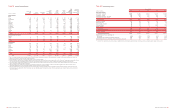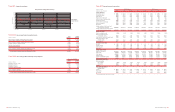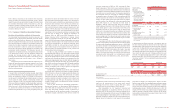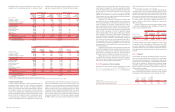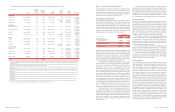Bank of America 2003 Annual Report Download - page 41
Download and view the complete annual report
Please find page 41 of the 2003 Bank of America annual report below. You can navigate through the pages in the report by either clicking on the pages listed below, or by using the keyword search tool below to find specific information within the annual report.
disclosure requirements of SFAS No. 123, “Accounting for Stock-
Based Compensation,” (SFAS 123) to require prominent disclosures
in both annual and interim financial statements about the method of
accounting for stock-based employee compensation and the effect of
the method used on reported results. The Corporation adopted the
fair value-based method of accounting for stock-based employee
compensation costs as of January 1, 2003. In accordance with SFAS
148, the Corporation has elected to use the prospective method of
adoption. All stock options granted under plans before the adoption
date will continue to be accounted for under Accounting Principles
Board (APB) Opinion No. 25, “Accounting for Stock Issued to
Employees,” (APB 25) unless these stock options are modified or
settled subsequent to adoption. SFAS 148 was effective for all stock
option awards granted in 2003 and thereafter. Under APB 25, the
Corporation accounted for stock options using the intrinsic value
method and no compensation expense was recognized, as the grant
price was equal to the strike price. Under the fair value method, stock
option compensation expense is measured on the date of grant using
an option-pricing model. The option-pricing model is based on certain
assumptions and changes to those assumptions may result in differ-
ent fair value estimates.
In accordance with SFAS 148, the Corporation provides disclo-
sures as if the Corporation had adopted the fair value-based method
of measuring all outstanding employee stock options in 2003, 2002
and 2001 as indicated in the following table. The prospective method
of accounting for stock options that the Corporation has elected to
follow, as allowed by SFAS 148, recognizes the impact of only newly
issued employee stock options. The following table presents the
effect on net income and earnings per common share had the fair
value-based method been applied to all outstanding and unvested
awards for the years ended December 31, 2003, 2002 and 2001.
(Dollars in millions,
Year Ended December 31
except per share data)
2003 2002 2001
Net income
$10,810 $9,249 $ 6,792
Stock-based employee
compensation expense
recognized during period,
net of related tax effects
78 ––
Stock-based employee
compensation expense
determined under fair
value-based method,
net of related tax effects(1)
(225) (413) (351)
Pro forma net income
$10,663 $8,836 $ 6,441
As reported
Earnings per common share
$7.27 $6.08 $ 4.26
Diluted earnings per
common share
7.13 5.91 4.18
Pro forma
Earnings per common share
7.18 5.81 4.04
Diluted earnings per
common share
7.05 5.64 3.96
(1) Includes all awards granted, modified or settled for which the fair value was required to be
measured under SFAS 123, except restricted stock. Restricted stock expense, included in
net income, for the years ended December 31, 2003, 2002 and 2001 was $276, $250 and
$182, respectively.
In determining the pro forma disclosures in the previous table, the
fair value of options granted was estimated on the date of grant using
the Black-Scholes option-pricing model and assumptions appropriate
to each plan. The Black-Scholes model was developed to estimate
the fair value of traded options, which have different characteristics
than employee stock options, and changes to the subjective assump-
tions used in the model can result in materially different fair value
estimates. The weighted average grant date fair values of the options
granted during 2003, 2002 and 2001 were based on the assump-
tions below. See Note 17 of the consolidated financial statements for
further discussion.
Compensation expense under the fair value-based method is recog-
nized over the vesting period of the related stock options.
Accordingly, the pro forma results of applying SFAS 123 in 2003,
2002 and 2001 may not be indicative of future amounts.
FASB Interpretation No. 45, “Guarantor’s Accounting and
Disclosure Requirements for Guarantees,” (FIN 45) was issued in
November 2002. FIN 45 requires that a liability be recognized at the
inception of certain guarantees for the fair value of the obligation, includ-
ing the ongoing obligation to stand ready to perform over the term of the
guarantee. Guarantees, as defined in FIN 45, include contracts that con-
tingently require the Corporation to make payments to a guaranteed
party based on changes in an underlying that is related to an asset,
liability or equity security of the guaranteed party, performance guaran-
tees, indemnification agreements or indirect guarantees of indebted-
ness of others. The accounting provisions of FIN 45 were effective for
certain guarantees issued or modified after December 31, 2002. The
adoption of FIN 45 did not have a material impact on the Corporation’s
results of operations or financial condition. In addition, FIN 45 requires
certain additional disclosures that are located in Notes 9 and 13 of the
consolidated financial statements.
BANK OF AMERICA 2003 7978 BANK OF AMERICA 2003
Bank of America Corporation and its subsidiaries (the Corporation)
through its banking and nonbanking subsidiaries, provide a diverse
range of financial services and products throughout the United States
and in selected international markets. At December 31, 2003, the
Corporation operated its banking activities primarily under two char-
ters: Bank of America, National Association (Bank of America, N.A.)
and Bank of America, N.A. (USA).
Note 1 Summary of Significant Accounting Principles
Principles of Consolidation and Basis of Presentation
The consolidated financial statements include the accounts of the
Corporation and its majority-owned subsidiaries, and those variable
interest entities (VIEs) where the Corporation is the primary bene-
ficiary. All significant intercompany accounts and transactions have
been eliminated. Results of operations of companies purchased are
included from the dates of acquisition. Certain prior period amounts
have been reclassified to conform to current period classifications.
Assets held in an agency or fiduciary capacity are not included in the
consolidated financial statements. The Corporation accounts for
investments in companies that it owns a voting interest of 20 percent
to 50 percent and for which it may have significant influence over
operating and financing decisions using the equity method of
accounting. These investments are included in other assets and the
Corporation’s proportionate share of income or loss is included in
other income.
The preparation of the consolidated financial statements in con-
formity with accounting principles generally accepted in the United
States requires management to make estimates and assumptions
that affect reported amounts and disclosures. Actual results could
differ from those estimates.
Recently Issued Accounting Pronouncements
In January 2003, the Financial Accounting Standards Board (FASB)
issued FASB Interpretation No. 46 “Consolidation of Variable Interest
Entities, an interpretation of ARB No. 51” (FIN 46). FIN 46 provides a
new framework for identifying VIEs and determining when a company
should include the assets, liabilities, noncontrolling interests and
results of activities of a VIE in its consolidated financial statements.
FIN 46 was effective immediately for VIEs created after January 31,
2003. As of October 9, 2003, the FASB deferred compliance under
FIN 46 from July 1, 2003 to the first period ending after December
15, 2003 for VIEs created prior to February 1, 2003. However, the
Corporation adopted FIN 46 on July 1, 2003, as originally issued, and
consolidated the assets and liabilities related to certain of its multi-
seller asset-backed commercial paper conduits. As of December 31,
2003, the total assets and liabilities were approximately $4.3 billion.
Prior periods were not restated. Prior to FIN 46, trust preferred secu-
rities were classified as a separate liability with distributions on
these securities included in interest expense on long-term debt. Upon
adoption of FIN 46, $6.1 billion of trust preferred securities vehicles,
which were deemed to be VIEs, were deconsolidated with the result-
ing liabilities to the trust companies included as a component of long-
term debt with no change in the reporting of distributions. In
December 2003, the FASB issued FASB Interpretation No. 46
(Revised December 2003) “Consolidation of Variable Interest
Entities, an interpretation of ARB No. 51” (FIN 46R). FIN 46R is an
update of FIN 46 and contains different implementation dates based
on the types of entities subject to the standard and based on whether
a company has adopted FIN 46. The Corporation anticipates adopt-
ing FIN 46R as of March 31, 2004 and does not expect that it will
have a material impact on the Corporation’s results of operations or
financial condition. For additional information on VIEs, see Note 9 of
the consolidated financial statements.
On May 15, 2003, the FASB issued Statement of Financial
Accounting Standards (SFAS) No. 150, “Accounting for Certain Financial
Instruments with Characteristics of both Liabilities and Equity” (SFAS
150) and was effective May 31, 2003 for all new and modified financial
instruments and otherwise was effective at the beginning of the first
interim period beginning after June 15, 2003. SFAS 150 changes the
accounting for certain financial instruments that, under previous guid-
ance, issuers could account for as equity. SFAS 150 requires that those
instruments be classified as liabilities (or assets in some circum-
stances). The adoption of this rule had no impact on the Corporation’s
results of operations or financial condition.
On April 30, 2003, the FASB issued SFAS No. 149, “Amendment
of Statement 133 on Derivative Instruments and Hedging Activities”
(SFAS 149) which is effective for hedging relationships entered into
or modified after June 30, 2003. SFAS 149 amends and clarifies
financial accounting and reporting for derivative instruments, includ-
ing certain derivative instruments embedded in other contracts and
for hedging activities under SFAS 133. The adoption of this rule did
not have a material impact on the Corporation’s results of operations
or financial condition.
SFAS No. 148, “Accounting for Stock-Based Compensation –
Transition and Disclosure – an amendment of FASB Statement No.
123,” (SFAS 148) was adopted by the Corporation on January 1,
2003. SFAS 148 provides alternative methods of transition for a
voluntary change to the fair value-based method of accounting for
stock-based employee compensation. SFAS 148 also amends the
Notes to Consolidated Financial Statements
Bank of America Corporation and Subsidiaries
Risk-free Interest Rates Dividend Yield
2003 2002 2001 2003 2002 2001
Key Employee Stock Plan
3.82% 5.00% 5.05% 4.40% 4.76% 4.50%
Broad-based plans(1)
n/a 4.14 4.89 n/a 4.37 5.13
Expected Lives (Years) Volatility
2003 2002 2001 2003 2002 2001
Key Employee Stock Plan
77726.57% 26.86% 26.68%
Broad-based plans(1)
n/a 44 n/a 31.02 31.62
n/a = not applicable
(1) There were no options granted under broad-based plans in 2003.





